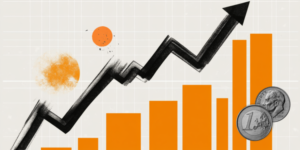For the week, the large cap equity indexes (S&P 500, Nasdaq, and the DJIA) were down in the -2.5% range, with small cap stocks (Russell 2000) down a bit more (-3.5%) (see table). For the year to date, the results are mixed – pretty much near the flat line except for the -5.26% performance of small cap Russell 2000.
Six of the large cap tech Magnificent 7 were also down for the week with GOOG being the exception. These are all off significantly from their peak levels with AAPL, TSLA and GOOG off double digits in 2025. Only MSFT and META are positive for the year. And with a weakening economy, the outlook for equities is clouded.
Moody’s Downgrade
The big financial news of the week was the Moody’s downgrade of U.S. debt from AAA to AA+, now joining Fitch and S&P. All three ratings agencies have now lowered the credit of the U.S. government to less than AAA. It is noteworthy that S&P lowered their rating 14 years ago (in 2011). Clearly, the iterations of Congress and the Executive Branch since that S&P downgrade paid little attention as business as usual prevailed. And, given the current reaction, or lack thereof, it doesn’t appear that the ratings downgrade will have any significant impact on the fiscal process. That is, business as usual will continue with future deficits as far as the eye can see! In our view, unless something changes, which appears unlikely, we could see more such downgrades.
It appears that the dollar’s status as the world’s reserve currency has given the U.S. an automatic pass when it comes to fiscal responsibility. It is also noteworthy that even after the Moody’s downgrade, the U.S. still has the worst balance sheet in terms of Deficit/GDP and Gross Debt/GDP of all other countries with the AA+ rating. This implies that, unless Washington D.C. takes this downgrade to heart, which appears to be highly unlikely, future downgrades are possible (if not probable). As an aside, we wonder why it took Moody’s so long to follow what S&P clearly saw 14 years ago.
Consumer Sentiment/Expectations
As seen from the chart, the latest University of Michigan’s Consumer Sentiment Index and their Index of Consumer Expectations are now at or below levels last seen in the Covid Recession three years ago.
Currently, there are no new stimulus checks in the works. And the U.S. consumer appears to be out of gas as they have depleted their savings (the savings rate currently is 3.9%; 9% is the norm). According to Wall Street Economist David Rosenberg, if not for the savings drawdown, GDP growth would be close to 0%.
A Slowing Economy
Recent data confirm that the economy is slowing increasing the probability of a Recession.
- Target (TGT) just reported year/year sales were down -3.8%;
- In Q1, retail businesses vacated a net of six million sq. feet (per Rosenberg Research);
- Retail sales rose +0.1% in April; in real (inflation adjusted) terms, they fell -0.2%;
- Delinquency rates are rising:
- Credit card delinquencies, at 12.3%, are at a 14 year high;
- Auto loan default rates rose to 5%; they were 4.4% a year ago;
- Default rates on HELOCs (Home Equity Lines of Credit) have doubled over the past year to nearly 1%;
- Student loan delinquencies have topped 10 million.
- A New York Fed Survey found that 1 in 9 respondents said they would be unable to meet a minimum debt payment over the next three months. This is the highest since May 2020 (Covid Recession).
- There were two significant stories in the May 22nd issue of the Wall Street Journal:
- Existing Home Sales fell -0.5% in April, negative now for three months in a row. They are down -2.0% from year ago levels, and are lower than they were in October ’08 (Lehman collapse) when the economy was in Recession. The median price fell -0.4% in April, and has been negative for four months in a row, the longest negative streak in nearly 14 years. On a year/year basis, the median sales price is only up 1.8%. It is our view that this statistic will soon turn negative.
Employment
Initial unemployment claims haven’t spiked. They have been steady in the 220K-240K range for the last few months. What is of concern is the number of Continuing Unemployment Claims. They are now over 1.9 million. This implies that those looking for jobs are finding it more and more difficult to land one. This also implies that, while companies appear to be hoarding their existing staff, they have significantly slowed down their new hiring. This is a significant leading indicator – one the Fed should be paying attention to.
Inflation
This is where there is good news. In April, the CPI rose +0.2% from March’s level. On a year/year basis, it was up +2.3% (vs. +2.4% in March) – so getting close to the Fed’s 2% target. The three-month trend was at a +1.6% annual rate, and, according to Economist David Rosenberg’s daily blog (May 23rd Breakfast with Dave) if current rents were used in the CPI calculation instead of rents lagged nearly a year, the three-month trend would have been a +0.7% annual rate, the slowest rate since October 2020 (Covid Recession). Note that this index showed a 3-month trend of +3.3% last December and +6.0% a year ago.
Final Thoughts
Equities were down slightly for the week, and struggling for the most part on a year-to-date basis. Not surprisingly, it’s a similar story for the Magnificent 7 tech stocks. Only Microsoft and Meta are positive for the year, with Apple, Tesla and Google down double digits with Amazon not far behind.
A negative bias in the financial markets isn’t surprising as Moody’s downgraded U.S. government debt to AA+, now joining Fitch and S&P (which lowered 14 years ago in 2011). That downgrade initially caused a spike in interest rates, but, given a slowing economy, by week’s end, rates fell back slightly with the 10 year, after peaking a 4.62% on Thursday (May 22nd) falling back to 4.50% by close of business on Friday (May 23rd),
Meanwhile, consumers have become downbeat. Target reported a -3.8% falloff in sales versus a year ago, and retail is reducing its footprint, something normally seen in Recessions. Even Walmart (WMT) feels profit pressure and is lowering its headcount. And, when consumers scale back their vacation plans, one knows economic weakness lies ahead.
Another sign of a weakening economy is rising delinquency rates. We see this in every major loan category (Credit Cards, Auto Loans, HELOCs, and Student Loans). A New York Fed Survey found that 11% of respondents said they won’t be meeting their minimum debt payments over the next three months.
Economic weakness also showed up in Existing Home Sales, with sales falling for three months in a row. In fact, they were lower in April than they were in October ’08 (in the midst of the Great Recession). Prices have fallen for four months in a row, a streak not seen for 14 years.
Continuing Unemployment Claims are rising. At the same time, Initial Unemployment Claims are not. These two facts imply that jobs are harder to find than they were several months ago. This is a leading indicator that implies upward pressure on the U3 unemployment rate over the next few months.
Meanwhile, inflation looks to be contained with the three-month trend in the CPI at a +1.6% annual rate. On a year/year basis, which is what the media and apparently the Fed watch, the CPI was up +2.3% in April, approaching the magic 2% Fed target.
The weak soft data (surveys etc.) have begun to appear in the hard data. Once again, because changes in monetary policy have a long lag before they impact the economy, the Fed looks to be behind the curve and late to the game. It is our view that the odds of a Recession are much higher than Wall Street believes.
(Joshua Barone and Eugene Hoover contributed to this blog.)
Read the full article here
















